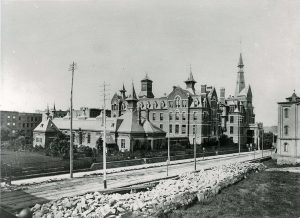Celebrating Two Notable Anniversaries in 2021
On St. Luke’s Day, October 18, 1846, the Rev William A. Muhlenberg announced to his congregation the of the Church of the Holy Communion that he believed they should established a church-related hospital in New York City to help support the poor in the community. He proposed that half of that morning’s collection be the first donation towards the goal of building such a hospital. Muhlenberg described the future hospital as a “Hotel Dieu,” – God’s Hotel, ‘a large hotel full of sick guests,’ or a “Christian family entertaining their guests, all of whom were sick.” After twelve years, and much fundraising, the doors to St. Luke’s Hospital opened to care for the sick poor of the City.

St. Luke’s Hospital’s 1858 site on W. 54th St.
Likewise, Mount Sinai Morningside’s sister hospital, Mount Sinai West, formerly Roosevelt Hospital, was also established to aid the city’s sick poor. James H. Roosevelt (1800-1863), experienced a life-altering illness that left him invalid. He decided to close his legal practice, cancel his wedding plans and devote his life to living frugally, carefully managing his fortune, to “establish … a hospital for the reception and relief of sick and diseased persons and for its permanent endowments.” Under the terms of James Henry Roosevelt’s will, the hospital was to be a voluntary hospital that cared for individuals regardless of their ability to pay. The Hospital opened in 1871 on West 59th Street between Ninth and Tenth Avenues. At its opening, Roosevelt Hospital was considered one of the most modern hospitals in the country.

Roosevelt Hospital in 1871
This year, 2021, we celebrate the 175th anniversary of the founding of St. Luke’s Hospital, now called Mount Sinai Morningside, and the 150th anniversary of the opening of Roosevelt Hospital, now called Mount Sinai West. During a time of pandemic, it may not be possible to have a big bash to celebrate the contributions, sacrifices, and simple hard work completed by the staff of these two hospitals. However, we can note the dates and celebrate in small ways, and be grateful for both hospitals that have provided dedicated health care, research, and innovations in medicine over so many years of service.
